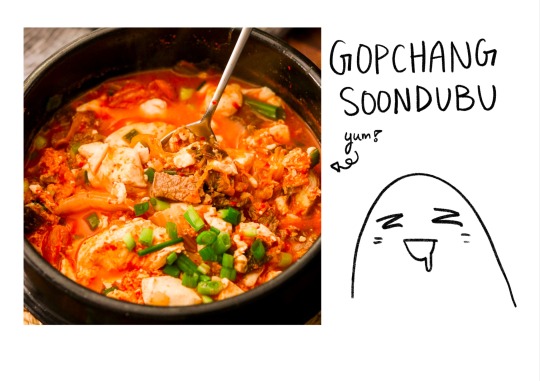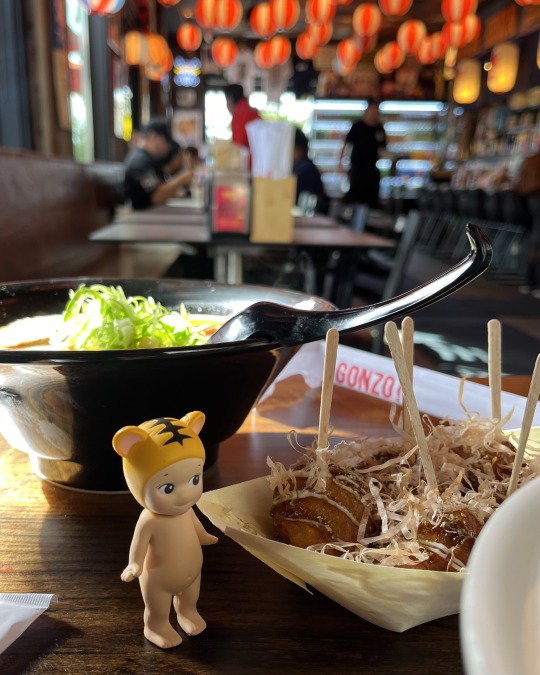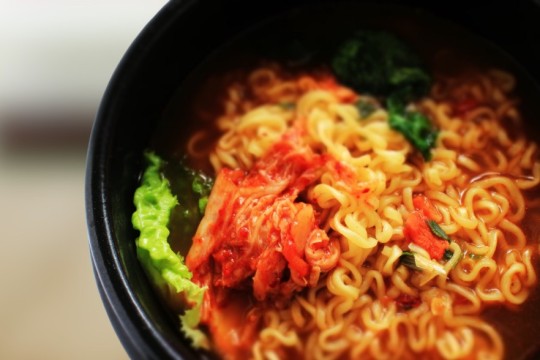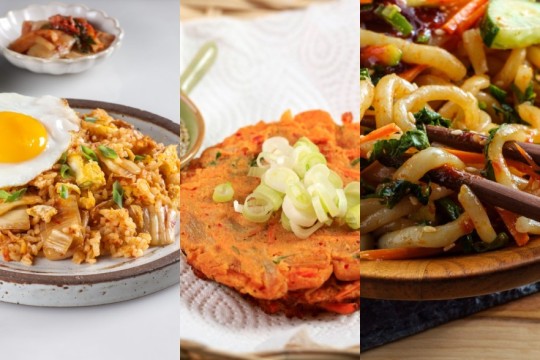#Korean Cuisine
Explore tagged Tumblr posts
Text

Jajangmyeon / Korean Noodles in Black Bean Sauce (Vegan)
#vegan#lunch#dinner#korean cuisine#east asian cuisine#veganized#jajangmyeon#black bean noodles#noodle bowl#noodles#potato#cabbage#tofu#onion#douchi#seaweed#garlic#soy sauce#applesauce#mushroom powder#molasses#mirin#coconut sugar#sea salt#pickles#radish
70 notes
·
View notes
Text

Korean twisted donuts : Kkwabaegi (꽈배기)
#donuts#raspberry#korean food#dessert#food#baking#donut#korean donuts#asian food#cinnamon sugar#sweet food#sweet#sweets#foodporn#delicious#cooking#food photography#foodgasm#recipe#twisted donuts#korean cuisine
319 notes
·
View notes
Text

Mandu (Korean Dumplings) filled with Pork, Garlic Chives & Glass Noodles. 🥟
#mandu#korean dumplings#dumplings#pork dumplings#asian food#korean food#korean recipes#korean cuisine#korean dishes#food pics#food blog#food#foodies#cooking#recipes#homecooking#sikfan kitchen#korean cooking#food recipes
762 notes
·
View notes
Text


Duuuuude!🤯 I just made beef bulgogi for the first time and it’s SO GOOD!💚🧡💛
#beef bulgogi#bulgogi#beef#quail eggs#mayak eggs#korean dreug eggs#drug eggs#korean eggs#korean cuisine#asian food#asian cuisine#cucumber#sesame seeds#rice#rice dish#food#food photography#foodpics#dinner#breakfast#lunch#healthy food#delicious#tasty#tastyfood#їжа
32 notes
·
View notes
Text

Korean Fried Chicken
📍Kokio Berlin
23 notes
·
View notes
Text


Seoul, Korea, May 2016, Spring
Budae Jjigae
3 notes
·
View notes
Text




Thought I’d share some fun tidbits abt my culture! And what better way to show it than ✨FOOD✨
Let me know if you wanna see more of this :)
#art#small artist#artwork#sketch#tf2#tf2 art#digital art#save tf2#team fortress#culture#korean culture#korean cuisine#food#korean food#sketches#fun facts#tf2 comics#my art
108 notes
·
View notes
Text

A zine featuring one of my favorite restaurants in Los Angeles - Western Doma Noodle! It showcases some of my favorite classic Korean dishes lovingly prepared at this establishment. Feel free to download and print from my ko-fi!
Image description in alt text.
4 notes
·
View notes
Text

Korean Cafe-Inspired Grapefruit Tea Spritz (Vegan) - video link
#vegan#drinks#korean cuisine#East Asian cuisine#iced tea#mocktails#grapefruit#white tea#chamomile#mint#sparkling water
241 notes
·
View notes
Text
instagram

#instagram#instagram post#kimchi#korean#instagram stuff#food#foodie#healthy food#korean cuisine#tw food#korean food#foodblogger#health#health and wellness#healthylifestyle#health & fitness#healthyliving#healthy eating#health tips#public health#health solutions#health lifestyle#health products#health post#health education#food talk#food recommendations#food rant#food ideas#foodblr
2 notes
·
View notes
Text

TTEOKBOKKI (Korean Spicy Rice Cakes) with Fish Cakes! 🔥
#tteokbokki#tteok#rice cake#korean rice cakes#spicy rice cakes#spicy food#korean food#korean dishes#korean cuisine#food pics#food blog#food#foodes#yummy food#sikfan kitchen#recipes
159 notes
·
View notes
Text
i needed to find out how long to soak something, wound up on youtube & now i got it BAD for this lady

yes salad-ppang is here but you know what she's really serving
found out her name is Maangchi (Hammer) bc it was her old MMORPG username and she couldn't be arsed to think of a new one and my heart was lost forever
#cooking#this lady#hnng#maangchi#korean cuisine#gosari#the true gateway drug to heartbreak#are you seeing those motherfucking sunglasses
31 notes
·
View notes
Text
Japchae - makaron ze skrobi słodkich ziemniaków z warzywami, omletem i grzybami shimeji




Wiem, wiem, zdjęcie z namoczonym makaronem połączonym z przyprawami nie wygląda zachęcająco. Przypomina... albo nie, nie napiszę z czym mi się kojarzy, bo wrażliwsi stracą apetyt.
Niemniej tak właśnie wygląda pierwszy etap przygotowywania japchae (czytaj: dżapcze), makaronu dangmyeon wytwarzanego ze skrobi słodkich ziemniaków, z kilkoma gatunkami warzyw, jajami w formie omletu, grzybami oraz (w wersji mięsnej) wieprzowiną lub wołowiną.
To lekko pikantno-słodkie danie kuchni koreańskiej, którego podstawą jest jasnoszary, półprzezroczysty, elastyczny makaron jest proste, smaczne i optymalne w serwowaniu. Można podawać je na ciepło, w temperaturze pokojowej lub na zimno z lodówki i jeść świeże lub następnego dnia. Latem robiłam je kilkakrotnie, bo świetnie sprawdzało się w roli nieobciążającego popołudniowego i wieczornego chłodnego posiłku.
Jeśli chodzi o dobór warzyw, to najczęściej w japchae pojawiają się marchew, szpinak, cebula i szczypior, a także jaja oraz grzyby (uszak bzowy, shiitake i boczniaki). Niektórzy wzbogacają to danie o kolorową paprykę, np. czerwoną lub/ i żółtą, szczypior czosnkowy, ogórek. Amatorzy mięsa dodają smażoną wołowinę (z niewielkim przerostem tłuszczu, np. antrykot, rostbef, łata) lub wieprzowinę (łopatka, polędwiczka).
Poszczególne składniki smaży się oddzielnie przed wymieszaniem ich z namoczonym/ ugotowanym (w zależności od producenta) i odsączonym makaronem i doprawia sosem sojowym, cukrem, siekanym czosnkiem i olejem sezamowym. Danie jest oprószone prażonymi nasionami sezamu.
Japchae powstało na dworze królewskim na początku XVII wieku i stanowiło elegancki posiłek koronowanych głów. Nie zawierało wówczas ani makaronu, ani mięsa, tylko warzywa i grzyby. Królowi Gwanghaegunowi tak bardzo smakowało, że awansował jego twórcę - Yi Chunga - na stanowisko równoważne sekretarzowi skarbu (od wiek wieków po dziś dzień miska dobrej strawy czy kiełbasa wyborcza zapewniały niektórym prestiżowe posady i wygrane wybory).
Spopularyzowane pod koniec XX wieku danie jest obecnie powszechnie podawane w Korei jako przystawka (banchan), pojawia się na przyjęciach weselnych, świętach, rodzinnych wydarzeniach czy bankietach.
Upały już wprawdzie za nami i instynktownie będziemy się rozglądać za treściwymi daniami i gorącymi zupami bardziej niż za zimnymi makaronami i chłodnikami, ale ten przepis warto zachować w notatniku.
Składniki:
300 g makaronu dangmyeon 6 łyżek sosu sojowego 1 1/2 - 2 łyżki cukru 2 łyżki oleju sezamowego 2 ząbki czosnku (lub łyżka ostrego oleju chili) marchew 2 garści szpinaku 2/3 czerwonej papryki cebula 3 gałązki szczypioru 100 g świeżych grzybów shimeji 2 jaja czarny pieprz do smaku 3 łyżki białego sezamu
Wykonanie:
W niewielkiej miseczce połączyć sos sojowy z cukrem, miodem, olejem sezamowym i rozdrobnionym czosnkiem lub ostrym sosem chili. Lubię doprawiać nim niektóre azjatyckie potrawy. Jeśli nie macie nic przeciwko dosmakowaniu koreańskiego dania chińską przyprawą, polecam go użyć. Jeśli zaś zależy Wam na oryginalnym, najbliższym oryginałowi smaku, wybierzcie czysty czosnek. Mojemu podniebieniu pasowały obie wersje.
Warzywa opłukać i osuszyć. Cebulę obrać i pokroić w cienkie półplasterki. Marchew obrać i pokroić w julienne. Paprykę pozbawić gniazd nasiennych i pokroić w paseczki. Odciąć końcówki grzybów i porozdzielać je. Szczypior pokroić w kawałki długości marchewki. Szpinak zblanszować (można użyć wody, którą potem wykorzystamy do makaronu) i dobrze wycisnąć.
Jaja rozkłócić, dosmakować solą, pieprzem. Na niewielkiej ilości oleju rzepakowego, na całej powierzchni patelni usmażyć cienki omlet. Po wystygnięciu podzielić wzdłuż na trzy pasy, złożyć je i pokroić na wąskie paseczki.
Na tej samej patelni, na sporym ogniu po kolei usmażyć wszystkie składniki. Nie przeciągać, marchew, papryka i cebula powinny pozostać jędrne. Za każdym razem wszystko doprawić odrobiną soli.
Makaron zalać gorącą wodą i odczekać 30 minut, aby napęczniał lub gotować zgodnie z instrukcją na opakowaniu (5-10 minut). Odcedzić na sicie, przelać zimną wodą, pociąć w kilku miejscach nożyczkami i wymieszać z przygotowanym sosem. Gdy cały zmieni barwę na lekko brązową, połączyć z pozostałymi składnikami. Robię to dłońmi, bo dużo lepiej i delikatniej rozdziela się nimi makaron, nie rwąc go. Spróbować i sprawdzić czy balans między smakiem słonym i słodkim jest zrównoważony.
Wykładać na talerze, skropić odrobiną oleju sezamowego, obsypać uprażonym na sucho sezamem i podawać (w temperaturze pokojowej lub po schłodzeniu w lodówce).
#japchae#japchae - prosty makaron ze skrobi słodkich ziemniaków z warzywami omletem i grzybami#japchae - simple sweet potato starch noodles with vegetables omelette and mushrooms#kuchnia koreańska#korean cuisine#dania wegetariańskie#vegetarian dishes#meatless meals#meatless dishes#sweet potato starch noodles#dangmyeon#sweet potato starch noodle#sweet potato vermicelli#korean vermicelli#cellophane noodles#jaja#egg#grzyby#mushroom#shimeji#grzyby shimeji#shimeji mushroom#szpinak#baby spinach#marchew#carrot#papryka#bell pepper
3 notes
·
View notes
Text

what do u think his favorite food is? 𓆝 𓆟 𓆞 𓆝 𓆟
#sonny angel#sonny angel tiger#ramen#ramen noodles#japanese ramen#udon#udon noodles#asian food#japanese food#korean food#korean bbq#korean corn dogs#vietnamese food#pho soup#pho noodles#vietnamese cuisine#japanese cuisine#korean cuisine#chinese food#chinese cuisine#food aesthetic#food diary#food art#food photography#sonny angel blog
17 notes
·
View notes
Text


Korean Fried Chicken @ Wondeo Chikin, Berlin
24 notes
·
View notes
Text
What Makes Kimchi and Kimchi Ramen So Fascinating?
Introduction

One standout creation is Spicy Kimchi Ramen, which combines the bold flavors of kimchi with the comforting essence of ramen, creating a unique and unforgettable meal. The surge in popularity of this dish reflects a broader global fascination with Korean food. In this blog, we’ll delve into the history of kimchi, explore the traditional kimchi recipe, and highlight the rise of Kimchi Ramen, along with other mouth-watering dishes that incorporate this ancient delicacy.
The Origins of Kimchi: A 2,000-Year Journey

One of the most celebrated traditions surrounding kimchi is "Kimjang," where families prepare large batches of kimchi during the cold months to ensure a year-round supply. This practice was key in preserving the traditional kimchi recipe, which has been passed down through generations. From its humble beginnings as a pickled side dish, kimchi has grown into a vital symbol of Korean culinary heritage and identity.
Kimchi in Modern Culture

Kimchi has become a symbol of Korean pride and is one of the key reasons behind Korea's recognition as a nation of bold, flavorful food. From breakfast to dinner, kimchi is served with nearly every meal in Korea. Globally, it has gained a reputation as a superfood, celebrated for its probiotic and antioxidant properties. As more people embrace healthy, fermented foods, kimchi’s presence in the global culinary scene continues to grow, finding its way into restaurants, food trucks, and even fine dining menus.
The popularity of kimchi has also led to the rise of various fusion dishes like Kimchi Ramen Bowls, which combine traditional flavors with modern appeal. With the growing demand for convenient options, many people are looking to buy kimchi ramen online or explore instant kimchi ramen for a quick and flavorful meal at home. For those searching for the best kimchi ramen to buy, this dish has become an essential part of the global food market, making it more accessible than ever.
The Rise of Kimchi Ramen: A Global Trend

Kimchi Ramen blends traditional Korean flavors with the convenience and global appeal of ramen. While ramen originated in Japan, Korean variations have flourished, and Kimchi Ramen has become a favorite for its rich, spicy broth. The tangy kimchi adds depth, and the spice brings heat, creating an unforgettable fusion of textures and flavors.
For those curious about this popular dish, knowing how to make kimchi is essential, as the preparation of this ingredient plays a key role in the flavor profile of the ramen. Additionally, the fermented kimchi benefits contribute to its growing popularity, highlighting its health advantages.
Kimchi Ramen is now widely available in various formats, from Korean restaurants and street food markets to instant kimchi ramen that can be enjoyed at home. The trend of Kimchi Ramen has exploded, with many seeking the best options available. Whether you’re looking to find kimchi ramen for sale or explore the kimchi ramen price, this dish appeals to foodies eager for bold flavors and a taste of Korean culture.
Dishes Related to Kimchi
Kimchi’s versatility allows it to be incorporated into a variety of dishes, adding its distinctive flavor to both traditional and modern cuisines. Here are a few popular dishes that revolve around this iconic ingredient:

Kimchi Jjigae (Kimchi Stew)
A hot and comforting stew made with authentic Korean kimchi, tofu, pork, or other proteins. Often served in a bubbling pot, the fermented kimchi adds depth and heat, making it perfect for cold weather.
Kimchi Bokkeumbap (Kimchi Fried Rice)
This quick and flavorful dish combines leftover rice with stir-fried kimchi. It’s often topped with a fried egg and can include other ingredients like vegetables, meat, or seafood. For those interested in preparing this at home, easy kimchi at home can enhance the flavors of this classic dish.
Kimchi Pancakes (Kimchijeon)
A savory pancake made from kimchi, flour, and other ingredients like scallions and seafood. These crispy, spicy pancakes are a popular snack or appetizer in Korea. You can use the best kimchi in India to bring an authentic taste to your pancakes.
Kimchi Udon
A Japanese-Korean fusion dish featuring thick udon noodles paired with spicy kimchi broth. This creates a satisfying and hearty meal that highlights the unique flavors of kimchi.
Kimchi Grilled Cheese
A modern twist on the classic grilled cheese sandwich, incorporating kimchi for an added layer of flavor and spice. The tangy kimchi cuts through the richness of the cheese, making it a perfect comfort food.
Kimchi Tacos
A fusion dish that has gained popularity in street food culture, where kimchi is paired with taco fillings like beef, pork, or tofu for a fresh, zesty kick.
For those who love kimchi ramen, consider ordering kimchi ramen online or exploring where to buy kimchi ramen to enjoy these dishes at home.
The Impact of Kimchi and Kimchi Ramen on Modern Culture

Kimchi has not only found its way into kitchens worldwide but has also made a significant impact on pop culture. Korean dramas, K-pop, and Korean food trends have reshaped global cuisine, with Kimchi Ramen emerging as a trendy, Instagram-worthy dish. Foodies and influencers frequently highlight kimchi-based dishes in their culinary adventures, further fueling its popularity.
For a taste of authentic Korean flavor in a convenient format, try Wang Ramen Korean Style Instant Noodles. Known for its rich, spicy broth and satisfying texture, this instant noodle packet offers the perfect solution for a quick meal that doesn’t compromise on quality. Whether you’re craving a late-night snack or a hearty lunch, Wang Ramen delivers the bold flavors of traditional Korean cuisine right to your bowl. You can easily find Wang Ramen on popular platforms like Amazon and Flipkart, or visit our online store to purchase directly. Enjoy the convenience of Korean street food from the comfort of your home with Wang Ramen!
Whether you’re looking for kimchi ramen near me, the best kimchi in India, or exploring options like vegan kimchi and instant kimchi ramen, the influence of kimchi on modern cuisine is undeniable, highlighting its role in both global food trends and personal health.
How to Make Kimchi

Making kimchi at home is a rewarding process that allows you to enjoy this spicy Korean kimchi at its freshest. To start, you'll need napa cabbage, radishes, garlic, ginger, and a mix of spices, including Korean chili flakes (gochugaru).
Prepare the Cabbage: Slice the napa cabbage and soak it in a saltwater solution to soften and draw out moisture.
Make the Spice Paste: Blend garlic, ginger, and gochugaru to create a spicy paste. You can adjust the spice level according to your preference for a more or less intense flavor.
Mix Ingredients: Combine the spice paste with chopped radishes, green onions, and any additional vegetables you like.
Pack and Ferment: Pack the mixture tightly into a jar, ensuring it’s submerged in its juices. It is to ferment at room temperature for several days before placing it in the refrigerator.
Kimchi is not just a tasty addition to meals; it also offers benefits like kimchi for gut health, thanks to its probiotic properties. It's a versatile ingredient that pairs well with many kimchi side dishes.
For those curious about the differences between fermented foods, kimchi vs sauerkraut shows that while both are fermented vegetables, kimchi’s distinctive spices and ingredients set it apart. Enjoy making your kimchi and savoring its unique flavors and health benefits!
Conclusion
Kimchi and Kimchi Ramen have made a lasting impact on global food culture, celebrated for their bold flavors and health benefits. From their ancient roots in Korea to their modern adaptations worldwide, these dishes showcase the versatility and richness of Korean cuisine. Whether you're enjoying a bowl of spicy Korean kimchi ramen at a street food cafe or preparing kimchi Ramen at home, these dishes offer a delicious taste of Korea’s culinary history.
The popularity of kimchi for gut health has further fueled interest in these traditional foods, blending both indulgence and wellness. As you explore the world of Korean cuisine, you may find yourself comparing kimchi vs sauerkraut, discovering the unique qualities that make kimchi stand out. For those seeking to experience these flavors, options to order kimchi ramen online or find kimchi ramen near me make it easier than ever to enjoy authentic Korean dishes. Embrace the rich, spicy flavors and the health benefits that come with them, and savor every bite of these global culinary treasures.
#Kimchi Ramen#Spicy Kimchi#Korean Cuisine#Kimchi History#Kimchi Benefits#Korean Food Trends#Kimchi Recipes#Kimchi in Modern Culture#Kimchi Stew#Kimchi Fried Rice#Kimchi Pancakes#Kimchi Udon#Kimchi Grilled Cheese#Kimchi Tacos#Kimchi Health Benefits#Korean Street Food#Korean Cafes#Vegan Kimchi#Instant Kimchi Ramen#Korean Food Culture#Kimchi vs Sauerkraut#Korean Street Food Cafe#Kimchi Ramen Online
3 notes
·
View notes